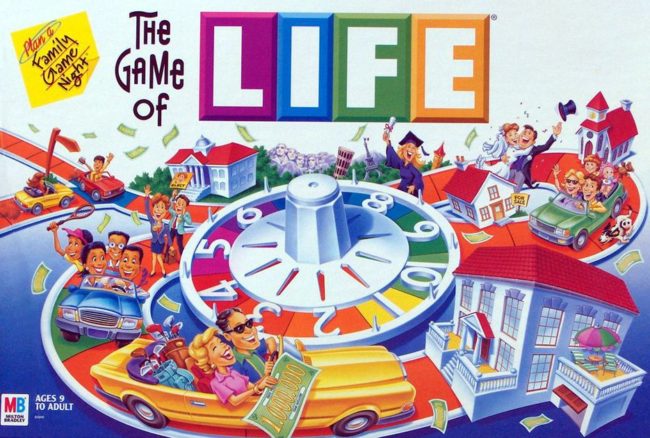By: Maria Cortner
The Game of Life®, a.k.a., Life, is a board game that simulates a person’s travels through his or her life, from college to retirement, with jobs, marriage, and possible children along the way. We wondered, “How well does The Game of Life® parallel some of the real choices we have to make over the course of our actual lives?” Such choices differ between various walks of life, and the struggles for an individual with intellectual and developmental disabilities involve a whole array of challenges that do not fit so nicely into the game of Life. In the game of Life, you encounter various spaces such as “job search,” “get married,” and “buy a house.”
 Move One: College vs. Career with I/DD
Move One: College vs. Career with I/DD
The first choice you have to make in the game of Life is career or college. This affects your “job search” at the first red space. If you choose to skip college and go straight to career your choices are much more limited. From the career cards, you pick one card at random, and you have to keep whatever card you get. There are also many careers that require a degree; therefore they are eliminated from the potential options. This process is the same for picking a salary — you have one choice and what you get is what you get; many of the higher paying salaries have already been eliminated.
If you do decide to go to college, you have to borrow $40,000 from the bank for tuition. When you reach the Career Choice space you have more options. You can pick three cards at random and choose from those three cards. You also have more salaries to choose from. No careers are eliminated, and higher paying salaries are more accessible. Just by attending college, the “players’” options are greater.
So let us play the game of life from the perspective of an individual with an intellectual or developmental disability. About a third of the students with disabilities who enroll in a four-year college or university graduate within eight years. For those who enroll in two-year schools, only around 40 percent graduate. A 2011 federal study that followed students for several years after high school graduation found that special education students were less likely to attend and complete college, and, if they joined the workforce, earned nearly $4 an hour less than former general education students. The issue with the game of Life is that it does not take into account the preceding difficulties of someone with intellectual disabilities. When you skip to the choice of college or career, potential employers ignore the importance and value of the person’s prior experience.
 Finding a Job: “Soft Skills” in Early Education
Finding a Job: “Soft Skills” in Early Education
The early education years often set the tone for the type of work experience an individual with an intellectual or developmental disability will gain. For example, high schools often neglect to teach the students soft skills that will often help them in higher education. This includes how to study, manage time, self-advocate, how to ask for help, or even how to simply organize a study group. These skills can make the difference between the college or career. Schools often focus on teaching to tests, resulting in a failure to provide students with effective communication and organization strategies.
Let’s assume that a person with a disability is able to choose college. The transition from academic to job search presents additional challenges for students with disabilities.
Without disabilities, the employment rate after college is 89.9%, yet for students with disabilities it is only 50.6%. Attending college doesn’t mean that people with disabilities won’t experience discrimination by employers in the hiring process.
A general misunderstanding by others of a student’s disability continues to impede the full success of that student.
The Next Move: Marriage
The next red space in the game of life is “get married.” Marriage equality as an issue for the disability community is not a new one. During the movement towards eugenics, people with disabilities were not only sterilized against their will, but they were also prohibited from marrying — this had long-lasting consequences. In Connecticut, Pennsylvania, Ohio, Kansas, Minnesota, and Michigan, people with intellectual disabilities, mental disabilities, and epilepsy were prevented from marrying, due to a series of laws that were passed in the early 20th century. Other states used legislation prohibiting anyone they considered to have a “genetic defect” from marrying. Beyond these laws, a person with a disability’s choice to get married is often based off of the class system.
Additionally, living with a disability is incredibly expensive. Many people with disabilities rely on programs such as SSI, SSDI, Medicare, Medicaid, Section 8, Welfare, and food stamps. However, remaining on these programs often keeps people living in poverty in order to continue to qualify. If an adult has a permanent disability, they can qualify for Medicaid as long as they also meet income and asset restrictions. Those restrictions can be as low as restricting a person to an income of $735 a month while owning no more than $2000 in assets. Removing themselves from the programs can be a matter of life or death.
 When a person with a disability gets married, the American government expects them to become the responsibility of their partner. The SSDI program is specifically for the adult children of people with a significant work history who have paid into the system. Usually, DAC (the Disabled Adult Children program) is awarded when a parent dies or retires. If the person were to marry, they become the “burden” of their partner, unless the partner also has a disability. In some instances, if both members of a couple are on DAC, both individuals may keep their benefits. Therefore, this red space is not so simple. The person cannot just thoughtlessly place another person in their care, and individuals with disabilities may be choosing between their basic necessities and marriage.
When a person with a disability gets married, the American government expects them to become the responsibility of their partner. The SSDI program is specifically for the adult children of people with a significant work history who have paid into the system. Usually, DAC (the Disabled Adult Children program) is awarded when a parent dies or retires. If the person were to marry, they become the “burden” of their partner, unless the partner also has a disability. In some instances, if both members of a couple are on DAC, both individuals may keep their benefits. Therefore, this red space is not so simple. The person cannot just thoughtlessly place another person in their care, and individuals with disabilities may be choosing between their basic necessities and marriage.
The Final Move: Purchasing a Home
The last red space is “buy a house.” This presents a whole array of new challenges in the life of a person with disabilities. The process of buying a home is not as simple as the game makes it to be for anyone, but certainly not for someone with disabilities, particularly if he or she receives government benefits.
The first challenge is the down payment on a house. Since a person with SSA benefits cannot own more than $2000 in assets, a down payment would surpass this cap. Purchasing a home would alert the SSA that the person spent more than the allotted funds on hand, which means the person could lose their benefits.
In addition, if they want to have a roommate, and the roommate pays a larger portion of the cost, this may be counted as an income, also potentially affecting their benefits. If someone receives Social Security Disability benefits, there are programs that can help them purchase a home. These programs may help fund the mortgage, but coming up with the funds for a down payment may require an additional assistance.
In the end of the game, everyone has faced choices, but the challenges of someone with disabilities make it more difficult to freely make these choices. Buying a home, getting married, choosing between college and career — these are choices that have so many more barriers for a person with a disability.
Building for Change will help individuals with disabilities, their families, and their caregivers to navigate the available resources for people with disabilities, while also offering a wide variety of life skills — you can learn more here.
Subscribe To Our Newsletter and SMS Reminders
The best way to ensure that you receive our newsletter, our event invitations, SMS reminders and other important information is to become a member of The Arc of the Pikes Peak Region.
The best way to ensure that you receive our newsletter, our event invitations, and other important information is to become a member of The Arc of the Pikes Peak Region.

